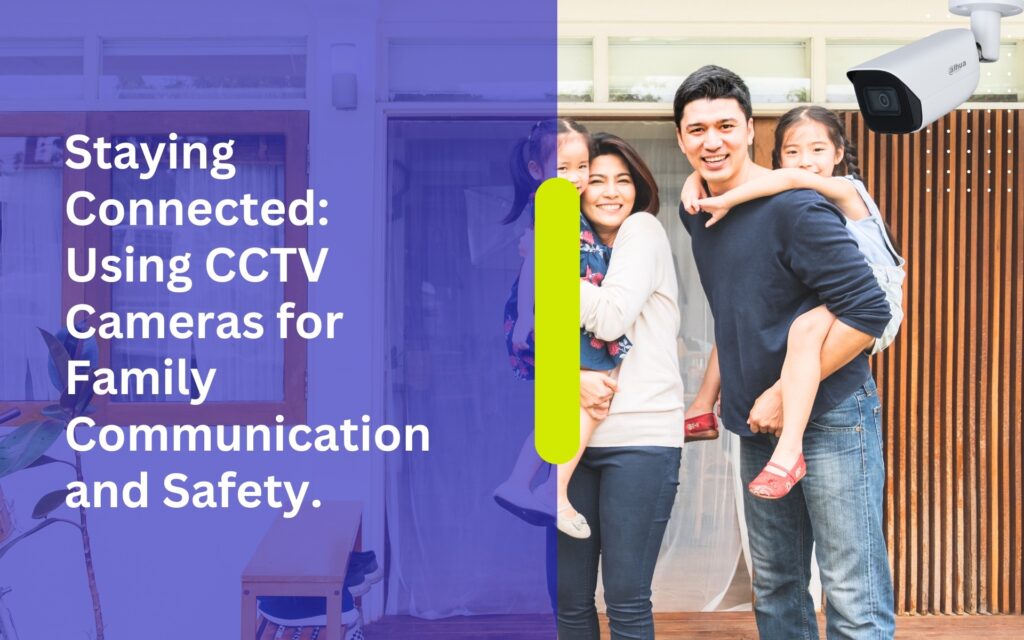CAT 6 Specs Overview. Introduction. In today’s fast-paced digital world, reliable network connectivity is no longer a luxury; it is a fundamental requirement for businesses, educational institutions, and homes. From seamless video …
Staying Connected: Using CCTV Cameras for Family Communication and Safety.

Introduction
In today’s fast-paced world, where the demands of work, school, and other commitments often pull family members in different directions, staying connected and ensuring the safety of loved ones has become a top priority for many households. The traditional concept of family communication, which once relied heavily on face-to-face interactions, has been significantly transformed by technological advancements. Among these advancements, Closed-Circuit Television (CCTV) cameras have emerged as a pivotal tool. Originally designed for basic surveillance, these cameras have now evolved into sophisticated devices equipped with features that extend far beyond mere observation, offering robust solutions for both communication and safety within the home.
The evolution of CCTV technology has been marked by significant advancements that have enhanced its functionality and usability in residential settings. Modern CCTV systems are equipped with high-definition (HD) and 4K resolution capabilities, providing crystal-clear images that can capture intricate details, such as facial features and license plate numbers. The shift from analog to Internet Protocol (IP) cameras has revolutionized remote access, enabling homeowners to monitor and control their CCTV systems from anywhere via smartphones, tablets, or computers. Additionally, the integration of Artificial Intelligence (AI) and Machine Learning (ML) has introduced advanced features like motion detection, facial recognition, and behavior analysis, transforming CCTV cameras into intelligent systems that can alert homeowners to unusual activities. The inclusion of two-way audio capabilities further enhances these devices, allowing for real-time communication and interaction with individuals within the camera’s view.
This article explores the multifaceted uses of CCTV cameras in family settings, emphasizing their benefits, the underlying technology, and best practices for their implementation. By leveraging these advanced features, families can enhance their communication and safety measures. The benefits of CCTV cameras are manifold: they enable remote monitoring of children and elderly relatives, facilitate emergency communication, and provide a deterrent against criminal activities. Understanding the technology behind these devices, including the roles of HD and 4K resolution, IP connectivity, and AI-enhanced analytics, is crucial for maximizing their potential. Moreover, implementing best practices, such as strategic placement, privacy considerations, secure access, and regular maintenance, ensures that CCTV systems operate effectively and ethically. This comprehensive approach not only safeguards the home but also strengthens the connections among family members, creating a more secure and cohesive living environment.
The Evolution of CCTV Technology
CCTV technology has come a long way since its inception. Originally developed for security purposes, these cameras were primarily used by businesses and public institutions to monitor premises. However, the integration of internet connectivity, high-definition video, and smart features has expanded their use into residential spaces.
Modern CCTV systems are equipped with:
1. High-Definition (HD) and 4K Resolution
Offering crystal-clear images that can capture minute details.
2. Internet Protocol (IP) Cameras
Enabling remote access and control via smartphones and computers.
3. Artificial Intelligence (AI) and Machine Learning (ML)
Enhancing motion detection, facial recognition, and behavior analysis.
4. Two-Way Audio
Allowing communication between the camera operator and individuals within the camera’s view.
These advancements make CCTV cameras a valuable tool for family communication and safety, extending beyond mere surveillance.
Enhancing Family Communication
One of the lesser-known benefits of CCTV cameras is their ability to facilitate communication within the household. Here’s how:
1. Remote Monitoring and Check-ins
Parents can remotely monitor their children while at work, ensuring they are safe and adhering to household rules. This is particularly useful for parents of teenagers or young children.
Families can check in on elderly relatives, ensuring they are safe and providing assistance if necessary. Cameras with two-way audio can help in reassuring and conversing with them, mitigating feelings of loneliness.
2. Home Intercom System
CCTV cameras with two-way audio function similarly to intercom systems. Family members can communicate with each other through the camera’s app. For example, calling everyone for dinner or asking for help with a task becomes easier.
3. Emergency Communication
In case of an emergency, such as a fire or medical issue, family members can use the camera’s audio features to alert others quickly. This can be crucial in ensuring a swift response and potentially saving lives.
Enhancing Family Safety
Safety remains a primary concern for families, and CCTV cameras provide numerous benefits in this regard:
1. Crime Deterrence and Detection
Visible cameras act as a deterrent to potential intruders. Knowing that the property is under surveillance reduces the likelihood of a break-in.
In the event of a crime, CCTV footage can provide critical evidence to law enforcement, aiding in the identification and apprehension of suspects.
2. Monitoring Vulnerable Areas
Areas like swimming pools, staircases, and kitchens can be monitored to prevent accidents. For families with young children, this is particularly important to prevent drownings, falls, and burns.
Cameras can be placed at entry points to ensure that children do not wander off and strangers do not enter unnoticed.
3. Visitor Verification
CCTV cameras at the front door or gate allow families to verify the identity of visitors before granting them access. This is particularly useful for preventing unauthorized access and ensuring that family members are safe from potential threats.
4. Night Vision and Motion Detection
Modern cameras come equipped with night vision, allowing for 24/7 monitoring. Motion detection alerts can notify homeowners of any unusual activity during the night, providing an additional layer of security.
Implementing CCTV Systems: Best Practices
To maximize the benefits of CCTV cameras for family communication and safety, it is important to implement them thoughtfully and strategically. Here are some best practices:
1. Strategic Placement
Entry and Exit Points: Cameras should be placed at all main entrances and exits to monitor who comes and goes.
High-Traffic Areas: Hallways, living rooms, and kitchens are good locations to keep track of daily activities.
Vulnerable Spots: Areas that are prone to accidents or unauthorized access, like staircases and backyards, should be monitored.
2. Privacy Considerations
Respect the privacy of family members by avoiding cameras in private spaces such as bathrooms and bedrooms. Ensure all family members are aware of camera locations and their purpose.
3. Secure Access
Protect your CCTV system with strong passwords and encryption to prevent unauthorized access. Regularly update the software to protect against vulnerabilities.
4. Integration with Other Smart Devices
Integrate CCTV cameras with other smart home devices, such as alarms and lights, for a comprehensive security system. This integration allows for automated responses, such as turning on lights when motion is detected.
5. Regular Maintenance and Monitoring
Ensure cameras are functioning correctly by performing regular maintenance checks. Clean lenses, check connections, and update software to keep the system running smoothly.
6. User Training
Educate all family members on how to use the CCTV system effectively. This includes accessing live feeds, responding to alerts, and using two-way audio.
Legal and Ethical Considerations
While CCTV cameras offer numerous benefits, it is important to be aware of the legal and ethical implications:
1. Legal Compliance
Ensure your use of CCTV cameras complies with local laws and regulations. This may include notifying visitors of surveillance, especially in areas where privacy is expected.
2. Ethical Use
Use CCTV cameras responsibly and ethically. Avoid using them to intrude on the privacy of neighbors or to monitor family members without their consent.
3. Data Protection
Protect recorded footage from unauthorized access and ensure it is stored securely. Consider using cloud storage solutions with robust security features.
The Future of CCTV in Homes
The future of CCTV technology holds exciting possibilities for family communication and safety. Advancements in AI and ML will continue to enhance the capabilities of these systems, making them more intuitive and responsive.
1. Smart Analytics
Future CCTV systems will likely feature more advanced analytics, capable of recognizing specific behaviors and alerting homeowners to potential issues. For example, cameras might identify when a child is approaching a dangerous area or if an elderly family member has fallen.
2. Integration with Wearables
Integration with wearable technology, such as smartwatches and fitness trackers, could provide additional data for monitoring health and safety. For instance, a wearable device could alert the CCTV system if a family member’s heart rate indicates distress.
3. Enhanced Connectivity
As smart home ecosystems become more interconnected, CCTV cameras will seamlessly integrate with other devices. This could allow for more complex automation, such as locking doors or shutting off gas supplies in response to specific triggers.
4. Privacy-Preserving Features
Future systems may include more sophisticated privacy-preserving features, such as masking certain areas of the footage or using anonymization techniques to protect individuals’ identities while still providing useful data.
Conclusion
CCTV cameras have transcended their traditional role of surveillance to become vital tools for family communication and safety. By leveraging modern features such as high-definition video, two-way audio, and smart analytics, families can stay connected and secure in ways that were previously unimaginable. However, it is crucial to implement these systems thoughtfully, respecting privacy and legal considerations while maximizing their benefits.
As technology continues to advance, the potential for CCTV cameras to enhance our lives will only grow, making them an indispensable part of modern family life. By staying informed and adopting best practices, families can harness the full potential of CCTV technology to create safer, more connected homes.
Related Articles
Celebrating a Year of Growth and Success at InstallersPH IT Solutions. Introduction. As the year comes to a close, InstallersPH IT Solutions takes a moment to reflect on a journey defined by …
Notice to the Public: Holiday Vacation Advisory of InstallersPH IT Solutions. Introduction. InstallersPH IT Solutions is committed to providing reliable and professional IT services to all our valued clients and partners. As …


